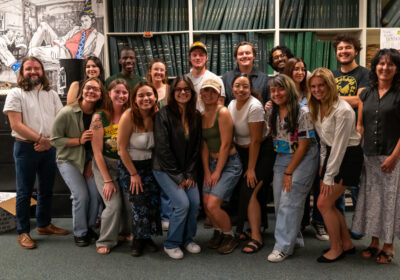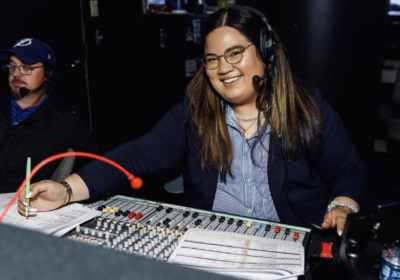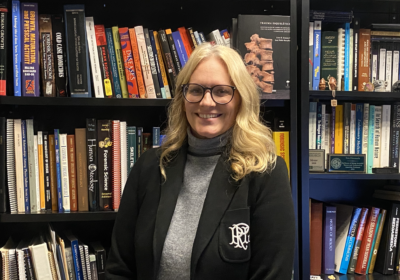Bulls bump elbows in roller derby
Bettie Kruger, Taz Maniac, Joan of Ache and Spank Sinatra are just a few pseudonyms adopted by the women of the Tampa Bay Derby Darlins (TBDD). High-impact skating, blocking and crashes have become major draws for fans of the all-female, flat track roller derby league.
Created from the ground up in October 2005 by Angela Kroslak, the TBDD has three home teams and four traveling/developmental teams. On March 3, the TBDD will kick off their 2012 season at USA’s Skateplex.
Though it’s known for flashy costumes and entertaining alter egos, roller derby is progressively being recognized as a sport rather than a spectacle. According to Derby Darlin’ Toni Santos, a junior majoring in biology whose derby name is “Tic Tac Toni,” roller derby is as physically demanding and dangerous as any other sport.
“Any sport has its risks, and roller derby is no different,” Santos said. “Everyone gets hurt eventually. But, if you love it, you’ll come back.”
Three months after joining the TBDD, Santos tore her Achilles tendon and sprained every ligament in her ankle. The injury took her out of the league for seven months.
Yet Santos said the entertainment elements of roller derby take a backseat to the athleticism demonstrated by the women.
“People are interested in seeing girls hit each other, for some odd reason,” Santos said. “We put on a show as far as our outfits go. But, the sport is still really serious.”
Each individual roller derby match is called a bout, in which the “blockers” guard the pack of skaters. The “pivot” takes off first and sets the pace. The skater on each team responsible for scoring, the “jammer,” starts 20 feet behind the rest of the pack, and must fight their way through.
The first jammer to make it through becomes the “lead jammer,” and scores points as they pass opposing skaters. The lead jammer can call off a jam by putting their hands on their waist. A typical jam lasts two minutes, and a bout has two 30-minute periods.
This high-impact sport is becoming more accessible to beginners. Brandy Moore, captain of the Black Widows travel team, said the TBDD league has developed an organized system to help acclimate new skaters to the sport.
“We don’t throw you out to the wolves or anything,” said Moore, who has been with TBDD since its inception and is better known as Bettie Kruger. “You’re going to learn at your level and at your pace, and then you can start scrimmaging with the rest of the league skaters.”
There is no archetypical derby woman. Players vary in age, race, class and occupation. Many of the Derby Darlins have managed to maintain a balance between their daily professions and family life.
Megan Sheffield, a reference librarian at USF specializing in science and math, said people often underestimate her because of her career and background. But that all changes when she transforms into Zelda Blitzgerald of the Switchblade Sisters.
“I know I’m a librarian, and in my previous career, I was a scientist,” Sheffield said. “I’m not exactly the most outgoing or athletic person. I knew a lot of people didn’t expect me to be doing roller derby, and that’s what made me want to succeed.”
The league trains about four nights a week. Along with the actual matches, these practices serve as a form of stress relief for the players. Santos, who recently became co-captain of the Bruise Crew, said she puts as much effort into roller derby as she does everything else in her life, including school and her part-time job at a Sumatra Bistro.
“Nothing is predictable,” Santos said. “You get to play against your friends and you get to play against people you don’t know. It’s a learning experience every time you step on the track.”
Though roller derby is a physical feat, it has evolved into a spectator sport. Returning fans and new faces show up to USA’s Skateplex for every TBDD match, drawn by the excitement of the sport.
Announcer Jim Palmer, an assistant professor at the USF College of Medicine for OB/GYN, said the fan experience is a pivotal part of derby life. Since he started in 2008, his goal has been encourage people to keep coming back.
“For me, it’s like watching a small business grow,” Palmer said. “I’m excited about the development of the entire organization – the growing budget, the YouTube videos. It all reaffirms that the sport is really catchy.”
The cultural fascination with the sport has spread worldwide. Last year, the first Roller Derby World Cup was held in Toronto, and TBDD’s Alyssha Littlefield, known as “Little A,” was selected to skate for Team USA. Recently, there have been campaigns to get roller derby recognized as an Olympic Sport.
Moore said that roller derby is a step forward in female empowerment.
“I think that girls are getting a lot more credit,” Moore said. “We get bumps, bruises and scrapes, and then we get up and do it again. It’s definitely a testament to how much a female can endure.”






